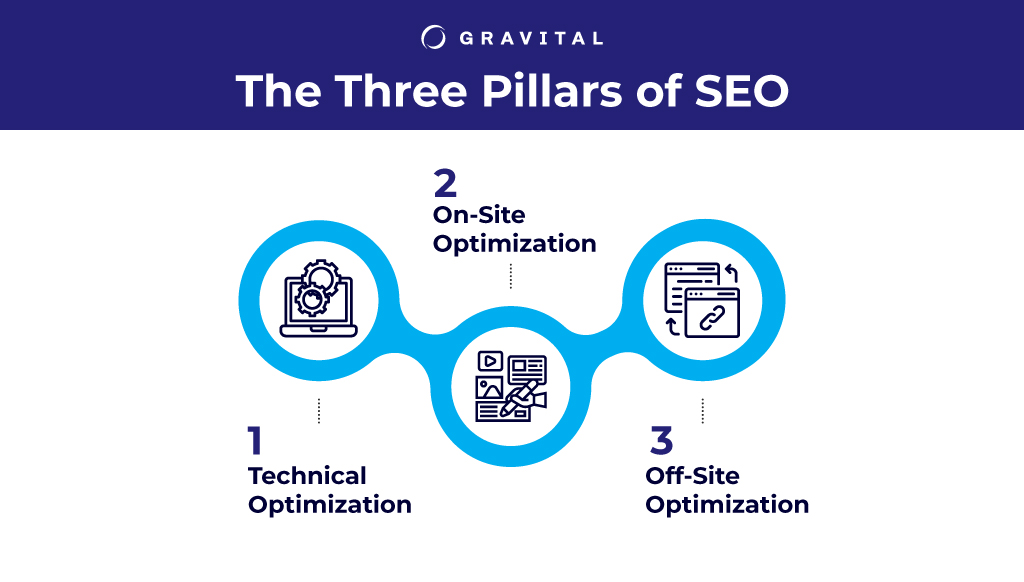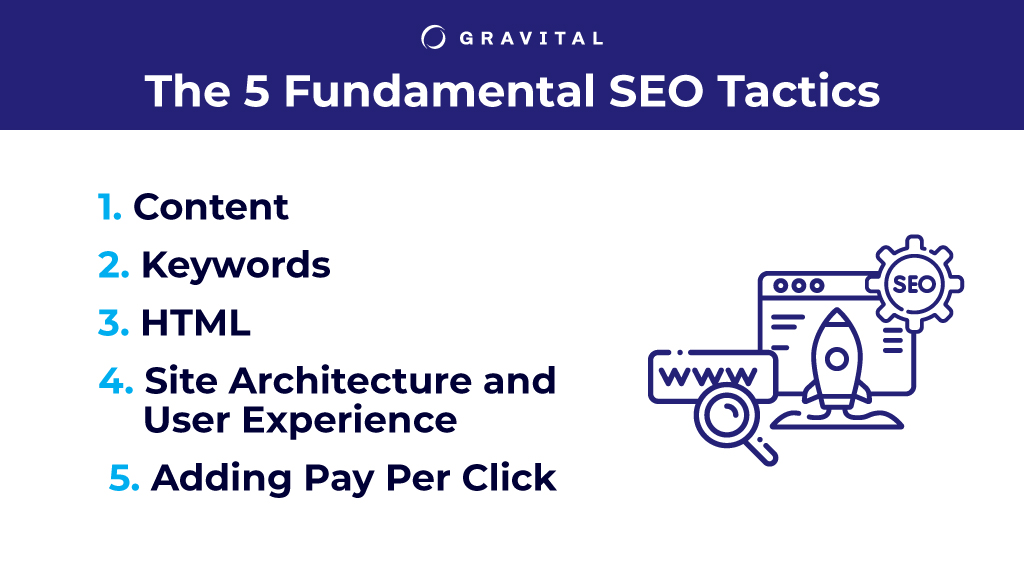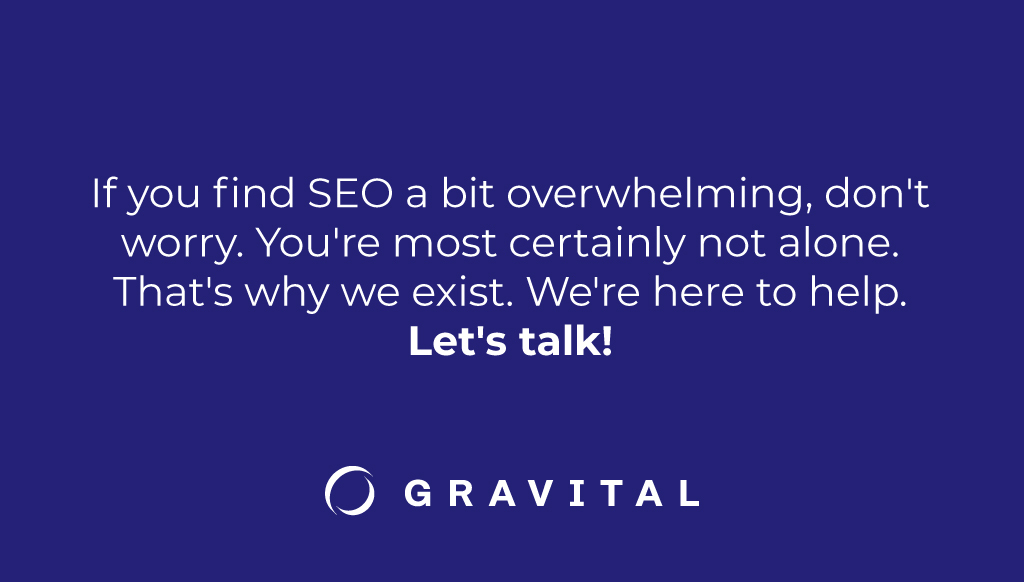Search engine optimization (SEO) is constantly evolving, keeping digital marketers and brands on their toes. But while algorithms and other search engine technologies change, the principles of SEO stay the same (at least for now).
If you’ve already tried to understand and learn SEO, then you already know that it can get complicated. Numerous (hundreds, reportedly) of ranking factors are involved in generating relevant search engine results. Fortunately, you don’t need to know them all.
SEO can be divided into core components and fundamental tactics or steps. In this article, we’ll go over the three pillars that support all key SEO ingredients and five basic tactics that make up a successful SEO strategy.


The Three Pillars of SEO
1. Technical Optimization
Technical optimization is the process of improving the behind-the-scenes performance, crawlability and indexability (how search engines find and catalog content) of websites, including site speed, usability, navigation, XML sitemap and mobile friendliness. Technical SEO, therefore, helps ensure that websites are fit to rank well on Google and other search engines.
This first pillar of SEO is particularly important for large websites that have hundreds or thousands of pages, such as e-commerce stores and social media platforms. Search engines need to be able to crawl and index every single page and repeat the process every time a new page is added.
2. On-Page Optimization
On-page optimization involves creating content that improves a website’s rankings on SERPs. To rank well, content needs to be relevant and useful to the people searching for it.
Following are some website content best practices:
- E-A-T: expertise, authority and trust are the three of the most important SEO elements of content. Search engines are designed to find and provide users with the best possible options in response to their search queries. Websites that show expertise, authority and trustworthiness are considered to be better by search engines.
- Tags: relevant tags on website content, such as page titles and meta descriptions, help pages rank higher on SERPs.
- Keywords: relevant keywords help optimize content for both the search engines and the users.
- Images: alternative text provides a written description of images, helping search engines to crawl and index them.
- Internal Links: these allow visitors to navigate to other pages on your website; the clickable or anchor text on a given link conveys the context and meaning of an internal link.
- Structured Data: snippets of code tell search engines what the content on web pages is about and allow them to display quick results (such as recipes, movie times, etc.) directly on the SERPs.
3. Off-Page Optimization
Off-page optimization refers to things, such as backlinks, that can influence your ranking on SERPs even though they’re not on your page. Backlinks are links on other websites that direct traffic to your website. The more backlinks your website earns, the better its reputation and the better its SERP ranking.
You can earn backlinks by creating content that people want to share and by developing partnerships with social media followers and bloggers, among others. Local search profiles, such as Google Maps, also boost off-page optimization.
For example, if someone writes an article about dog groomers and includes a link to your website in the article, that backlink is extremely valuable for your SEO strategy and your business. Backlinks show search engines and website visitors that your brand has a good reputation and is a trustworthy expert and authority in your industry.


The 5 Fundamental SEO Tactics
An effective SEO marketing strategy calls for various tactics. Here are five that every SEO effort should include.
1. Content
Creating high-quality content and optimizing it for search engines and users is at the core of SEO. Search engines want to, need to, provide the most relevant, accurate search results possible. And users want the same thing: the most relevant and accurate search results. Content is the backbone of SEO.
Elements of Remarkable Content
- Quality: valuable content is relevant, useful and helpful; it can also be entertaining and educational.
- Keywords: good content includes phrases that people use to search for that content online.
- Intent: the content must match the intent of the person doing the search based on the keywords used.
- Freshness: publishing fresh, new content and updating existing content is good for SERP rankings.
2. Keywords
For content to do its job, it must contain relevant keywords with good search traffic potential. The wrong way to use keywords is to stuff as many as possible in the content, whether it matches user intent or not. The right way is to use keywords naturally in the content, that is, in a way that doesn’t seem artificial or forced.
Effective keyword research, identification and selection requires the use of keyword research tools such as Semrush, Ahrefs and Google Trends.
3. HTML
HTML elements–meta descriptions, title tags and alt text–should never be ignored when designing and implementing a SEO marketing strategy. These elements tell search engines more about the content of a website and what visitors can expect when they land on that site.
Without proper HTML, the search engines would struggle to figure out what your content is about and why it should rank higher than your competitors’ content.
Elements of HTML
- Title Tags: what shows up when the page appears on SERP and what’s displayed in the tab at the top of the browser.
- Meta Descriptions: the area below the title tag that tells users what the site or page’s content is about.
- Heading Tags: there are headlines and subheadlines; H1, for example, is the title of an article and the website’s primary header.
- Alt Text: this text is used to describe images with words, which helps search engines crawl and index them.
- URL Slug: the part of the URL after the last backslash is a powerful keyword that signals to search engines and users what the page is about.
4. Site Architecture and User Experience
The architecture of a website focuses on its design and functionality and directly affects user experience (UX). Websites should make it easy for search engines to crawl, index and rank them. Websites that load too slow, that are difficult to navigate or hard to use in a mobile device negatively influence UX and search results rankings.
Elements of Effective Site Architecture and UX
- XML Sitemap
- Page Speed
- Mobile-Friendliness
- Navigation
- Usability
- SEO Marketing
- HTTPS and SSL (security)
5. Adding Pay Per Click
Pay-per-click, or PPC, is a paid advertising method, such as Google Ads, that companies use to display ads on SERPs. The ads appear in a designated ad space area above or below organic search results. When people click on these ads, the companies pay a per-click fee to the search engine or advertiser.
Using PPC with SEO offers the following advantages:
- Wider Reach: brands can reach more people through a combination of SEO and PPC, including people outside their target audience who may become new customers.
- Quicker Results: PPC ads can be seen within minutes of being placed and, therefore, have the potential of driving traffic to a website almost immediately; SEO provides long-term benefits but takes longer to produce results.
- Message Testing: by using both SEO and PPC, you can test different messages to see which ones work best with your target audience.
- Cost-Effective: PPC can supplement organic traffic already being driven by SEO efforts, making it a cost-effective marketing strategy.
There are other SEO marketing tactics and steps that brands serious about SEO should consider, such as social media marketing, responsive website design, local SEO, voice search optimization, SEO analytics and metrics (to measure results and adjust strategies), video marketing and pillar pages, to name a few.
Working on Your SEO Strategy
Are you ready to tackle SEO? Here are some first steps to get you started:
- Educate yourself about SEO (you’ll find many resources online).
- Audit of your website content.
- Research, identify and use the right keywords.
- Create high-quality content and optimize existing content.
- Optimize all of your HTML elements.
- Supplement your SEO efforts with PPC.
- Look for opportunities to earn backlinks.
- Focus on website design and functionality.
- Seek ways to improve user experience.
- Purchase SEO and/or content marketing tools.
- Measure your website’s performance.
- Monitor your change in rankings and traffic.
- Rinse and repeat!
Final Thoughts
In digital marketing, a SEO strategy is a comprehensive plan to reach and attract more visitors to your website through search engines. What for? To turn those visitors into customers.
Effective SEO comprises technical, on-page and off-page optimization as well as several fundamental SEO marketing tactics. While this process isn’t easy, it should not be ignored or neglected, unless one is planning for failure.




